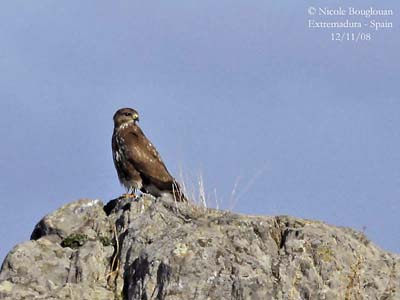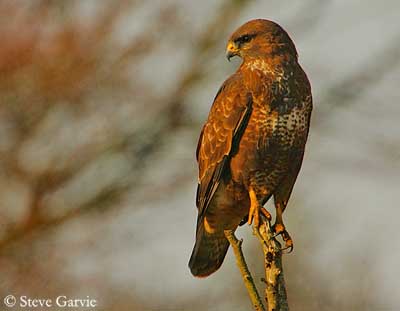
Eurasian Buzzard
Buteo buteo
Accipitriforme Order – Accipitridae Family
BIOMETRICS:
Length: 50-57 cm
Wingspan: 113-128 cm
Weight: M : 525-1180 g – F : 625-1365 g
DESCRIPTION:
Usually, oldest birds are much darker, but plumages may be extremely variable, giving this raptor its French name.
Eurasian Buzzard usually has dark brown upperparts.
Underparts are paler, almost white, with brown and reddish streaks on belly.
We can see a collar, more or less distinct, on the lower breast, allowing identifying the bird in wild.
Primaries are dark, almost black, and we can see a dark trailing edge. The short, broad tail is greyish- brown, with broad, dark terminal band, and 12 narrower.
Eyes are yellow-brown. Bill is blackish with yellow cere and gape. Legs and feet are yellow.
Fr: Buse variable
All : Mäusebussard
Esp : Ratonero común
Ital : Poiana eurasiatica
Nd : Buizerd
Russe : Обыкновенный канюк
Sd: Ormvråk
Photographers:
Audevard Aurélien
OUESSANT DIGISCOPING
Bouglouan Nicole
PHOTOGRAPHIC RAMBLE
Garvie Steve
RAINBIRDER Photo galleries
Jean Marc Rabby
Des Ailes et des Plumes
Text by Nicole Bouglouan
Sources:
HANDBOOK OF THE BIRDS OF THE WORLD Vol 2 by Josep del Hoyo-Andrew Elliot-Jordi Sargatal - Lynx Edicions - ISBN: 8487334156
GUIDE DES RAPACES DIURNES – Europe, Afrique du Nord et Moyen-Orient de Benny Génsbol – Delachaux et Niestlé – ISBN : 2603013270
THE COMPLETE BOOK OF BRITISH BIRDS – Written by “Royal Society for the Protection of Birds” experts - Préface de Magnus Magnusson - Michael Cady- Rob Hume Editors - ISBN: 0749509112
THE HANDBOOK OF BIRD IDENTIFICATION FOR EUROPE AND THE WESTERN PALEARCTIC by Mark Beaman, Steve Madge - C.Helm - ISBN: 0713639601
BIRDS OF THE MIDDLE EAST by R.F. Porter, S. Christensen, P Schiermacker-Ansen C.Helm - ISBN: 0713670169
BIRDS OF THE GAMBIA AND SENEGAL by Clive Barlow and Tim Wacher – Helm Field guides – ISBN: 0713675497
BIRDS OF PREY OF AFRICA AND ITS ISLANDS by Alan and Meg Kemp - Struik Publishers - ISBN: 1770073698

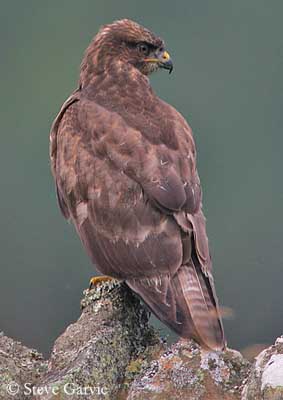
Immature resembles adult but paler, with streaked underparts. Head is streaked white or yellowish. Wings and back show sharp reddish feather’s edges. Tail often lacks the terminal band. Eyes are grey but change very soon. Bill is blackish with yellow cere and gape.
They reach the adult plumage at about 16 months.
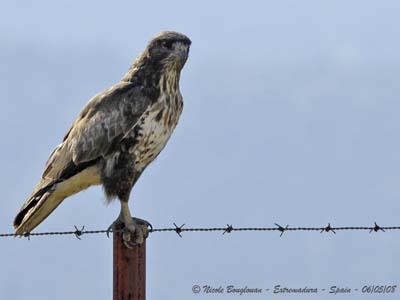
JUVENILE
With grey bill and legs
We can find several subspecies sharing the wide range. Races differ in size, coloration and plumage pattern.
VOICE: SOUNDS BY XENO-CANTO Eurasian Buzzard’s call is similar to high-pitched mewing, often repeated when the bird perches, and mainly in flight. This call may be heard at some distance and reveals its presence.
During the breeding season, female responds to the male with the same call, and both adults often performs duets.
In autumn, while the birds are flying in family groups, this call is given by adults and youngs.
At nest, sounds are more raucous, similar to clucking.
HABITAT:
Eurasian Buzzard is closely related to the forest. It frequents all types of forests, as in the country or in mountains, but always close to open area. We can also find it in areas with scattered trees, in cultivated fields and rocky areas in mountains.
During winter, it frequents open fields, steppes and wet areas, mostly in flat country at moderate elevation, whereas during summer, it feeds beyond the tree-line in mountains.
RANGE:
Eurasian Buzzard breeds in Europe, except in extreme North of Scandinavia, Iceland and part or Ireland.
Populations living in the northern parts of Europe migrate southwards to France in winter.
BEHAVIOUR:
Eurasian Buzzard often appears as lazy bird. Although it is very active, often flying in open, soaring over fields and forests, it also spends long time perched in high poles.
It favours trees, pylons, rocks and all exposed perches.
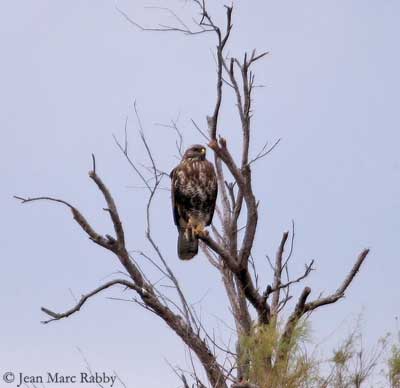
Eurasian Buzzard feeds on small mammals caught on the ground, but also on birds, reptiles, amphibians and insects. This species is very adaptable, that probably explains the very good reproduction. This raptor is famous by its manner to hunt the moles. It watches on the ground, and when the earth moves, it swoops down from the perch and catches the prey without hesitation.
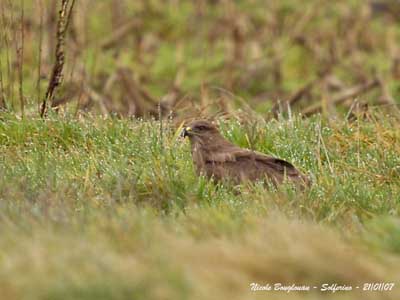
Most part of the preys is caught after being localized by sight, while circling at low height, but also at distances of more than 100 metres.
Eurasian Buzzard probably has the keenest view of all the raptors. But hearing is important too because it is able to detect the movements of a mouse in the grass.
Once the prey is detected, the bird flies down by slow soaring towards the ground. It runs quickly and easily, and catches the prey.
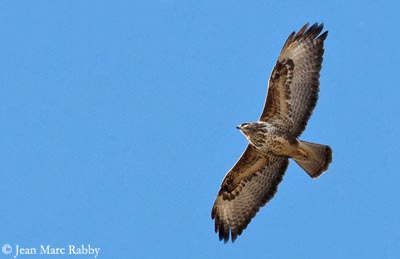
According to the range, and mainly in most Europe, the Eurasian Buzzard is sedentary and very territorial. A pair with an established territory will remain there all the life. The youngs born of this pair disperse in the surroundings and occupy the vacant areas.
Towards mid-January, the territoriality increases with the breeding season coming. It is common to observe displays or attacks towards intruders of the same species.
In February, flight displays increase and continue into March. Both mates perform ellipses, glides and dives while flying together.
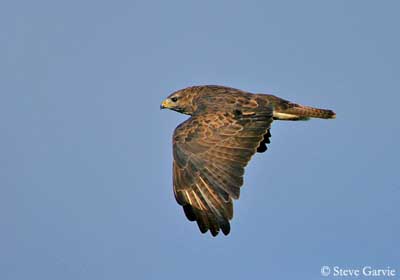
If the Eurasian Buzzard is mobbed by crows or gulls, it turns onto its back while flying and scratches the intruder.
FLIGHT:
Eurasian Buzzard has slow and laboured flight when taking off, but once at some height, it soars slowly and rises easily in spiral. When at good height, the buzzard performs wing-beats and flies directly to the forest, or soars very high.
If the currents are strong, it bends the wings and dives at great speed, with almost closed wings and tail, to a perch.

REPRODUCTION:
Laying occurs between late March and May according to the range.
Eurasian Buzzard’s nest is placed in tall tree, deciduous or conifer, between 6 and 30 metres above the ground, in fork or branch close to the trunk. It is a bulky platform made with sticks, roots and small branches. Interior is lined with green leaves coming from the nearby trees.
Female lays 3-4 eggs at 2-3 days intervals. Male may replaces female if she leaves the nest occasionally. It gives her the preys and feeds her during incubation. It also watches on the nest-site by soaring permanently over the territory, while hunting.

Incubation lasts about 33-38 days, until the last chick was born. Youngs are covered in greyish-brown down, with dark patch around the eyes, and white below. Some feathers grow about 12 days later.
If there is too much difference in chicks during the first days, the abundant preys brought by parents at nest make then of equal size very soon. However, there is always a much smaller chick which often dies trampled by the others.
At one month, the youngs are able to eat the preys brought at nest, but even after leaving the nest, about 50-60 days later, they remain dependent on parents until late summer when they disperse. They are independent about 6-8 weeks after hatching.
They can breed at 2-3 years old.
DIET:
Eurasian Buzzard feeds on small and medium-sized mammals (rodents, voles, mice, rats, young rabbits and hares…), also birds (up to size of pigeons, pheasants and partridges), reptiles, amphibians and insects (beetles, crickets and locusts), and earthworms. It may sometimes feed on carrion, depending on season and range.
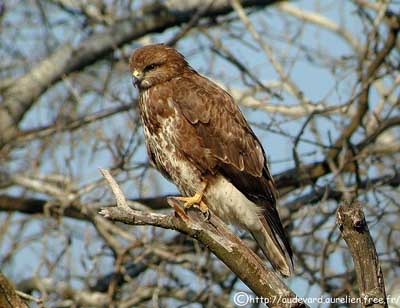
PROTECTION / THREATS / STATUS:
Eurasian Buzzard has stable populations. This raptor is common in Europe.
Some declines have been recorded due to persecutions, poisoning by pesticides or baits, habitat loss and rarity of preys.
